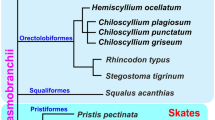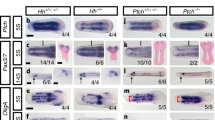Abstract
Members of the bone morphogenetic protein (BMP) family actively promote ventral cell fates, such as epidermis and blood, in the vertebrate gastrula. More dorsally, the organizer region counteracts BMP signalling through secretion of BMP-binding antagonists chordin and noggin, allowing dorsally derived tissues such as neurectoderm and somitic muscle to develop1. BMPs also function in skeletal development and regeneration of bone following injury2. Noggin antagonism is thought to prevent osteogenesis at sites of joint formation3, whereas chordin has not yet been implicated in skeletogenesis. Analyses of zebrafish mutants have confirmed the action of chordin (chd) in opposing ventralizing signals at gastrulation4,5,6. Some ventralized mutants recover and develop into fertile adults, thereby revealing a requirement for chd function for the later processes of fin and caudal skeletal patterning. We observe in mutants the misexpression of genes encoding BMPs and putative downstream genes, and ectopic sclerotomal cells. Through injections of chd mRNA into the early embryo, we restored wild-type gene expression patterns, and the resultant fish, although genotypically mutant, developed normal axial skeletons and fins. Our results demonstrate that chordin function during gastrulation is important for the correct morphogenesis of the adult zebrafish skeleton.
This is a preview of subscription content, access via your institution
Access options
Subscribe to this journal
Receive 12 print issues and online access
$209.00 per year
only $17.42 per issue
Buy this article
- Purchase on Springer Link
- Instant access to full article PDF
Prices may be subject to local taxes which are calculated during checkout




Similar content being viewed by others
References
Thomsen, G.H. Antagonism within and around the organizer: BMP inhibitors in vertebrate body patterning. Trends Genet. 13, 209– 211 (1997).
Hogan, B.L.M. Bone morphogenetic proteins: multifunctional regulators of vertebrate development. Genes Dev. 10, 1580–1594 (1996).
Brunet, L.J., McMahon, J.A., McMahon, A.P. & Harland, R.M. Noggin, cartilage morphogenesis, and joint formation in the mammalian skeleton. Science 280, 1455–1457 (1998).
Hammerschmidt, M. et al. dino and mercedes, two genes regulating dorsal development in the zebrafish embryo. Development 123, 95–102 (1996).
Schulte-Merker, S., Lee, K.J., McMahon, A.P. & Hammerschmidt, M. The zebrafish organizer requires chordino. Nature 387, 862–863 (1997).
Fisher, S., Amacher, S.L. & Halpern, M.E. Loss of cerebum function ventralizes the zebrafish embryo. Development 124, 1301– 1311 (1997).
Solnica-Krezel, L. et al. Mutations affecting cell fates and cellular rearrangements during gastrulation in zebrafish. Development 123, 67–80 (1996).
Postlethwait, J.H. et al. Vertebrate genome evolution and the zebrafish gene map. Nature Genet. 18, 345–349 (1998).
Hammerschmidt, M., Serbedzija, G. & McMahon, A.P. Genetic analysis of dorsoventral pattern formation in the zebrafish: requirement of a Bmp4-like ventralizing activity and its dorsal repressor. Genes Dev. 10, 2452– 2461 (1996).
Jabs, E.W. et al. A mutation in the homeodomain of the human MSX2 gene in a family affected with autosomal dominant craniosynostosis. Cell 75, 443–450 ( 1993).
Satokata, I. & Maas, R. Msx1 deficient mice exhibit cleft palate and abnormalities of craniofacial and tooth development. Nature Genet. 6, 348–356 ( 1994).
Winograd, J. et al. Perinatal lethality and multiple craniofacial malformations in MSX2 transgenic mice. Hum. Mol. Genet. 6, 369–379 (1997).
Akimenko, M.A., Johnson, S.L., Westerfield, M. & Ekker, M. Differential induction of four msx homeobox genes during fin development and regeneration in zebrafish. Development 121, 347–357 (1995).
Maeda, R. et al. Xmsx-1 modifies mesodermal tissue pattern along dorsoventral axis in Xenopus laevis embryo. Development 124, 2553–2560 (1997).
Marazzi, G., Wang, Y. & Sassoon, D. Msx2 is a transcriptional regulator in the BMP4-mediated programmed cell death pathway. Dev. Biol. 186, 127–138 (1997).
Suzuki, A., Ueno, N. & Hemmati-Brivanlou, A. Xenopus msx1 mediates epidermal induction and neural inhibition by BMP4. Development 124, 3037 –3044 (1997).
Monsoro-Burq, A.H. et al. The role of bone morphogenetic proteins in vertebral development. Development 122, 3607– 3616 (1996).
Nornes, S. et al. Zebrafish Pax9 encodes two proteins with distinct C-terminal transactivating domains of different potency negatively regulated by adjacent N-terminal sequences. J. Biol. Chem. 271, 26914–26923 (1996).
Chiang, C. et al. Cyclopia and defective axial patterning in mice lacking Sonic hedgehog gene function. Nature 383, 407– 413 (1996).
Teillet, M.-A. et al. Sonic hedgehog is required for survival of both myogenic and chondrogenic somitic lineages. Development 125, 2019–2030 (1998).
Miller-Bertoglio, V., Fisher, S., Sánchez, A., Mullins, M. & Halpern, M.E. Differential regulation of chordin expression in zebrafish mutants. Dev. Biol. 192, 537–550 (1997).
Marques, G. et al. Production of a DPP activity gradient in the early Drosophila embryo through the opposing actions of the SOG and TLD proteins. Cell 91, 417–426 (1997).
Piccolo, S. et al. Cleavage of Chordin by Xolloid metalloprotease suggests a role for proteolytic processing in the regulation of Spemann organizer activity. Cell 91, 407–416 (1997).
Ashe, H.L. & Levine, M. Local inhibition and long-range enhancement of Dpp signal transduction by Sog. Nature 398, 427–431 (1999).
Connors, S.A., Trout, J., Ekker, M. & Mullins, M.C. The role of tolloid/mini fin in dorsoventral pattern formation of the zebrafish embryo. Development 126, 3119– 3130 (1999).
Miller-Bertoglio, V. et al. Maternal and zygotic activity of the zebrafish ogon locus antagonizes BMP signaling. Dev. Biol. 214, 72–86 (1999).
Westerfield, M. The Zebrafish Book (University of Oregon Press, Eugene, Oregon, 1995).
Kimmel, C.B., Ballard, W.W., Kimmel, S.R., Ullmann, B. & Schilling, T.F. Stages of embryonic development of the zebrafish. Dev. Dyn. 203, 253– 310 (1995).
Joly, J.S., Joly, C., Schulte-Merker, S., Boulekbache, H. & Condamine, H. The ventral and posterior expression of the zebrafish homeobox gene eve1 is perturbed in dorsalized and mutant embryos. Development 119, 1261– 1275 (1993).
Chen, J.N. et al. Left-right pattern of cardiac BMP4 may drive asymmetry of the heart in zebrafish. Development 124, 4373–4382 (1997).
Acknowledgements
We thank our colleagues, especially D. Brown and V. Miller-Bertoglio, for useful discussions and critical reading of the manuscript; P. Jagadeeswaran for guidance in radiographic techniques; E. Melancon and J. Eisen for helpful discussions on skeletal development; E. Mountcastle-Shah, W. Driever, E. Egan, W. Talbot, D. Wagner and M. Mullins for sharing information with us before publication; and M. Macurak, A. Hennessy and S.-J. Kim for technical assistance. This work was supported by a Clinical Investigator Development Award from NINDS to S.F. (NS01851-02) and a Pew Scholar Award to M.E.H.
Author information
Authors and Affiliations
Corresponding author
Rights and permissions
About this article
Cite this article
Fisher, S., Halpern, M. Patterning the zebrafish axial skeleton requires early chordin function. Nat Genet 23, 442–446 (1999). https://doi.org/10.1038/70557
Received:
Accepted:
Issue Date:
DOI: https://doi.org/10.1038/70557
This article is cited by
-
Pleiotropic functions of chordin gene causing drastic morphological changes in ornamental goldfish
Scientific Reports (2022)
-
Insertional mutagenesis in ChordinA induced by endogenous ΔTgf2 transposon leads to bifurcation of axial skeletal systems in grass goldfish
Scientific Reports (2019)
-
TGF-β and BMP signaling in osteoblast, skeletal development, and bone formation, homeostasis and disease
Bone Research (2016)
-
Citalopram and sertraline exposure compromises embryonic bone development
Molecular Psychiatry (2016)
-
Open and closed evolutionary paths for drastic morphological changes, involving serial gene duplication, sub-functionalization and selection
Scientific Reports (2016)



